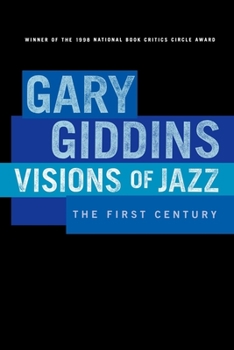Visions of Jazz: The First Century
Select Format
Select Condition 
Book Overview
Poised to become a classic of jazz literature, Visions of Jazz: The First Century offers seventy-nine chapters illuminating the lives of virtually all the major figures in jazz history. From Louis Armstrong's renegade-style trumpet playing to Sarah Vaughan's operatic crooning, and from the swinging elegance of Duke Ellington to the pioneering experiments of Ornette Coleman, jazz critic Gary Giddins continually astonishes the reader with his unparalleled...
Format:Paperback
Language:English
ISBN:0195132416
ISBN13:9780195132410
Release Date:May 2000
Publisher:Oxford University Press, USA
Length:704 Pages
Weight:2.25 lbs.
Dimensions:1.4" x 6.1" x 9.2"
Customer Reviews
5 ratings
Hard to find a better book on jazz !
Published by Thriftbooks.com User , 21 years ago
Veteran jazz critic Gary Giddins is immensely articulate and intelligent, and yet so readable and user-friendly. As erudite as he is, he never pontificates, or "talks down" to the reader, as many jazz writers often do. Few writers can "hear" the music as well as he does -- and he somehow transmits this to the reader. Not content to be merely an historian, Giddins can also analyze a Charlie Parker solo with the best of them (as he does here), and his musical knowledge is formadible. He provides telling accounts and anecdotal information of the great jazz players and singers with great authority, a strong command of the language and an intrinsic love for this music. Of the dozens of books on jazz I have read, this is still my favorite. Each refreshing chapter stands on its own, and as a jazz player and teacher, I simply can't recommend a better book than "Visions of Jazz".
The new standard jazz history
Published by Thriftbooks.com User , 23 years ago
Gary Giddins has performed a remarkable feat. He has covered one hundred years of jazz history in one volume. At 700 pages it is big for sure but it is well researched and very readable. At first glance it appears that Giddins has structured and organized the book in the worst possible way by having one chapter on each of the seminal figures of jazz history, and in semi chronological order. The pitfall here is that it lends itself to a book that looks like lots of note cards strung together. This structure can also obscure the larger picture; jazz is not just the history of a bunch of individuals. Giddins very skillfully avoids both of these traps. Each chapter is well researched, filled with anecdotes about the musician or group, and through the chapters flows the larger background of the historic movements and issues in the development of jazz. Giddins also approaches jazz with a refreshing "inclusiveness" and wastes precious little energy in defining what jazz is or in dismissing various movements as "unpure" or other such nonsense. In fact he makes the point right up front that jazz owes as much to popular music for its genesis as it does to spirituals or black folk music. In the chapter on Irving Berlin he points out that Tin Pan Alley was a mixture of black, Jewish and other ethnic blends of music, and in fact, Berlin was even accused of having an underground railroad of black song writers in his back room that he was ghosting for. And this, at the time, was not meant as a compliment..Of course, jazz cannot be discussed in a vacuum and race plays an important part in its history. Giddins adds two bits of trivia, which I find speak volumes in themselves about where we are and where we have come from. One was that Al Jolson lobbied Gershwin for the part of Porgy. He, thankfully, did not get it. Second was that Ellington's all black orchestra played in an Amos and Andy movie in the 30's and the producer had the lighter skinned members of the orchestra blacked up with makeup for the scenes. I suppose this was to dispel any idea in the minds of the movie audience that the band might be integrated.The book lacks a recommended discography, which would have been valuable. Giddins does comment on the recordings of his subjects in their respective chapters so that is a big help. There is a 2 CD companion set with the same title which is a nice-to-have but it is largely an afterthought and the only connecting material is the 4 inch square flimsy comment sheets that come with the CD which does not really relate back to the book itself. This is a essential book for any jazz lovers library.
This is a wonderful book !.`
Published by Thriftbooks.com User , 23 years ago
I am 57 years old, a white, suburban male, with almost no experience in jazz. I know what I like, but I don't know why, and although I enjoy older generations of singers and songs, many of the people in this book are unfamiliar beyond their names. That is the triumph of this book. It is so well written, so beautiful and rapsodic,so educational and entertaining, I want to learn more, hear more, and find the connections. The only thing I wish were included were photographs and a 10 cd set to hear the music the author refers to. Now, I have to get a saxophone or trumpet !
Outstanding
Published by Thriftbooks.com User , 24 years ago
The research and time but into this indepth overview of the first century of jazz is absolutely remarkable. Discussing the most influential and popular jazz artists of the century, this book gives insight into the artists and their music as well. Absolutely outstanding!
Remarkable Study
Published by Thriftbooks.com User , 24 years ago
This is an outstanding, invaluable guide to jazz. I recommend it fully, with just one caveat -- not enough coverage of the incredible influence of Brazilian music (percussion, bossa nova, rhythms, MPB composers) on jazz. For that reason, one should also consult "The Brazilian Sound" (Temple University Press) as a supplement to this work.




